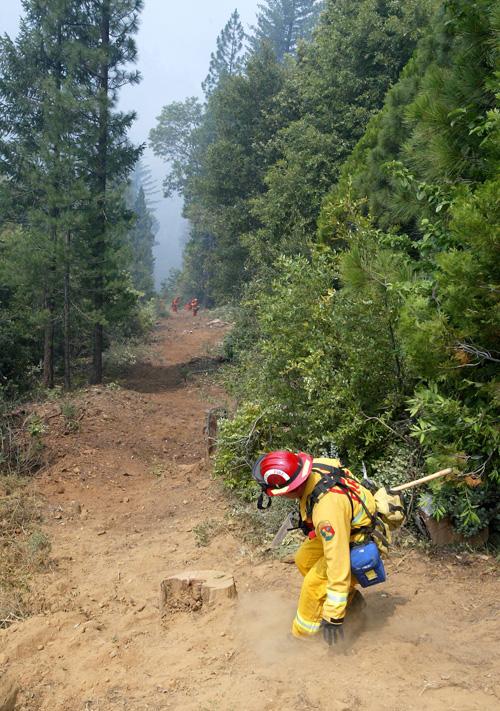Wildfires force firefighters to pick their battles
Fire Captain-Division Supervisor Todd Tindill hikes down a hill to help firefighters contain the West Fire near Stirling City, Calif., Monday. Hundreds of wildfires burned across central and northern California for a second week Monday. The Associated Press
July 1, 2008
SAN FRANCISCO – With hundreds of wildfires raging across remote, rugged parts of California for a second week, fire officials have been forced to strategically choose which to fight and which to leave to burn for weeks or even months.
The number of fires burning in central and Northern California – more than 1,000 according to state fire officials – means authorities can’t send firefighters to battle every blaze, Jason Kirchner, a spokesman for the U.S. Forest Service, said Monday.
“It’s like eating an elephant – you’ve got to eat it one bite at a time,” he said.
It’s also impossible to attack wildfires in some rugged, remote areas because the risk to firefighters is too great, he said.
“We have to take a step back, figure out where the best place is to make a stand and sometimes wait for the fire to come to us in those situations,” he said. “We’ve got to pick the battles we can win.”
Get The Daily Illini in your inbox!
Long-running wildfires are not unusual in California. It was four months before firefighters controlled a blaze that blackened more than 240,000 acres of Santa Barbara County backcountry last year.
What is extraordinary this year is the number of fires burning at the same time, Kirchner said. The weekend of June 21, some 1,200 fires were burning – a figure Forest Service officials said appeared to be an all-time record in California.
The Forest Service put the figure at about 600 on Monday. It attributed the gains to its tactic of attacking small fires first, and to significant assistance from other states and Canada.
State officials, however, counted more than 1,000 ongoing blazes. The source of the discrepancy was apparently a different counting method.
Also unusual, Kirchner said, was that there have been no significant injuries to civilians or firefighters even though some 570 square miles have burned in California this season. There were, however, a few minor injuries as harsh terrain hampered firefighters’ efforts to battle a blaze in the Shasta-Trinity National Forest.
“It is extremely steep, very rugged territory, and there are a lot of injuries, twisting ankles, slipping on hills,” Kirchner said. Burning debris is “rolling downhill right past your containment line. It’s very complicated, difficult, dirty firefighting work.”
Even so, firefighters managed to increase their containment of that 30,000-acre fire from 15 to 23 percent.
Two wildfires choked parts of the Sierra Nevada foothills, sending up plumes of smoke that darkened patches of the 100-mile stretch between Sacramento and Reno.
The fires in the Tahoe National Forest blanketed portions of the Interstate 80 corridor linking the two cities and the foothill communities in between where tens of thousands of people live.
Along the Pacific, fire officials said fog and humidity helped them gain ground against a blaze that was just 3 percent contained in the storied town of Big Sur. John Heil, a spokesman for the U.S. Forest Service, said it had blackened about 39,600 acres.
Firefighters poured personnel and equipment into the area to ensure the fire did not reach the town, said John Ahlman, a spokesman for the Los Padres National Forest.







